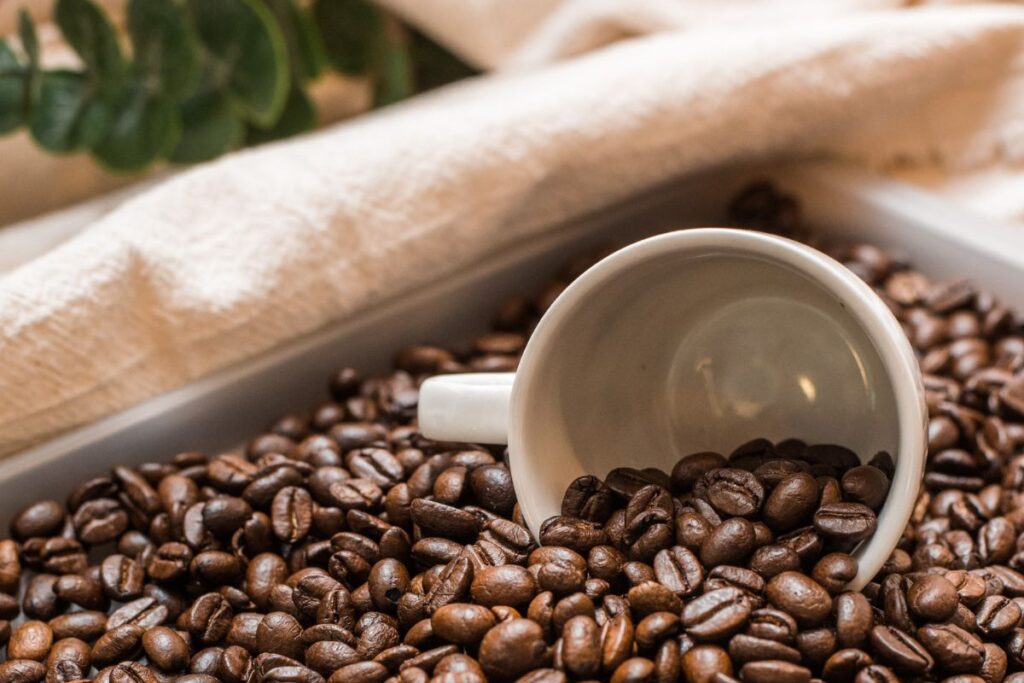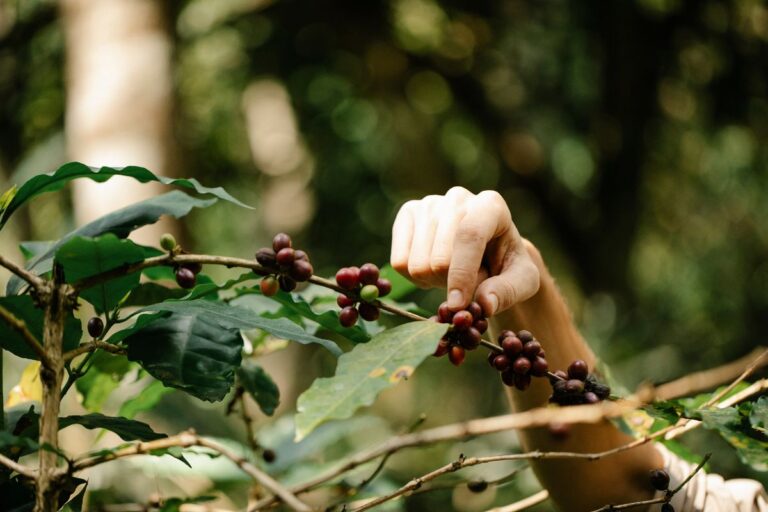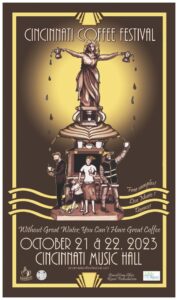Which one will you try?
Will you be a conformist and drink Arabica because it is more popular due to the fact that it is sweeter and thus considered to be higher quality?
Or will you be the outlier, and choose Robusta because it has a higher caffeine content?
The choice is yours and I encourage you to try both to find your favorite.
I remember trying Robusta coffee for the first time instead of my usual Arabica, thinking: now that’s different, I am going to choose that variety next time!
Perhaps after reading you will do the same.
There are dozens of different varieties of coffee. With coffee grown all over the world at different climates and altitudes, it’s no wonder why.
However, there are only two main types that are the most important as they are the most predominant and the ones that most likely end up in your morning cup of joe: Arabica and Robusta.
By Andrew.
Affiliate disclosure
This page may contain affiliate links – we may earn a small commission when you make a purchase through these links. This is at no extra cost to you.
From 2020 to 2021, about 102 million 132-pound bags of Arabica coffee and about 74 million 132-pound bags of Robusta were produced globally.
That’s a lot of coffee!
Now is the time to learn more about these two types of coffee.
With this ultimate guide, you will learn about Arabica vs. Robusta coffee, their taste, differences, and more.
By the way, have you had a look at our resources and deals page yet?
Coffee Bean Types: Four Main Varieties But Only Two That Matter
What are the different types of coffee beans? Arabica and Robusta are types of coffee beans.
There are two other varieties as well, Excelsa and Liberica.
Each species has several subtypes that make the number of different kinds in the dozens.
Arabica accounts for about 75 to 80 percent of global coffee production and Robusta accounts for about 25 percent.
The amount of Excelsa and Liberica coffee production is so small that it is almost insignificant.
With that said, let’s talk about the altitude where coffee is grown.
Arabica vs. Robusta Altitude (where coffee is grown?)
So, where are Arabica and Robusta grown?
Arabica and Robusta have different characteristics as a result of where they are grown.
The bottom line: the altitude of Arabica vs. Robusta coffee plants matters.
Where is Robusta Coffee Grown
Robusta grows at about 3,000 feet in regions near the equator with a high amount of rainfall.
Some places where Robusta is grown include West Africa, South America, and central and western Asia where the average temperature is around 80 degrees Fahrenheit and the main exports are cocoa beans and bananas.
In order to flourish, Robusta coffee plants require a lot of water and higher temperatures.
They would not survive in cold conditions.
Where is Arabica Coffee Grown
Arabica usually grows at around an average of 5,000 feet in areas with a temperate climate, such as in the mountains or tropical regions.
When coffee is grown at higher elevations where harsher weather conditions are present, it produces harder beans.
Harder beans have a slower rate of maturing, which means more complex sugars are present inside the bean.
And it is generally agreed upon that this type of bean, compared to the softer type, is better quality.
Arabica Coffee Plant vs. Robusta Coffee Plant: What are the Differences?
Arabica Coffee Plant
The Arabica coffee plant is a small tree, classified as an evergreen shrub.
When it is unpruned, it can grow up to sixteen and a half feet tall.
Its leaves are a dark green color, shiny, and very thin.
The flowers that are produced by this plant are white and have a sweet scent.
Robusta Coffee Plant: Tall and Robust
The Robusta coffee plant is very similar to the Arabica plant, but there are also some key differences.
It is also an evergreen shrub, but is taller and grows to be about thirty feet tall.
Robusta has a bigger crop yield than Arabica, contains less sugar, and it costs less to care for.
It is also more resistant to pests than Arabica.
It is easier to grow, and this characteristic of being a “robust” species of coffee plant, became its name.
Arabica Coffee History: From Humble Beginnings to a Global Phenomenon
Arabica coffee has a unique history. Arabica coffee trees are endemic to Ethiopia.
That is where they were first discovered to have effects on mental clarity, especially during prayer sessions.
They started to be grown for commercial purposes in Yemen.
Coffee started to become the drink of choice in the Arabic region in the fifteenth century.
Why?
Muslims were prohibited from drinking alcohol so they fused coffee drinking into their culture instead.
Coffee houses in the region began to spring up and started to serve their concoction to people from around the world.
Soon the appeal of coffee spread throughout the world.
Even though the exportation of coffee was first strictly prohibited by Arabia, an Indian man on his pilgrimage to Mecca was so impressed by the drink, that he smuggled some coffee beans back to his home country.
This began the spread of coffee to other economies besides the Arabian Peninsula, including the European colonies.
Soon thereafter, geography became an important factor of good quality coffee and superior coffee taste.
Robusta Coffee History: A Late Bloomer
What about the history of Robusta?
Robusta coffee originated from Africa.
The finding of Robusta coffee trees in the Congo paved the way for this type of coffee to be grown at lower altitudes in the 19th century.
In the beginning of the 20th century, there was a rapid proliferation of Robusta coffee plantations.
This increase in Robusta coffee production was paused during World War II, but resumed shortly thereafter, acquiesced with the independence of several African nations, and was supported by the government, particularly in the countries of Cote d’Ivoire and Cameroon.
Robusta was and continues to be grown also in Asia and Brazil.
The countries of India, Indonesia, the Philippines, and Vietnam are known for their Robusta cultivation.
And Vietnam is now the second largest producer of coffee in the world, second only to Brazil.

Arabica Coffee Taste: Superior in Taste and Body
Arabica coffee is often considered to have a better taste and to be better quality than Robusta.
This is due to the fact that the beans, as discussed earlier, contain more sugar because of their slower maturation rate (due to the climate and altitude at which the beans are grown), which leads to the production of a harder bean.
The taste of Arabica coffee is sweeter and smoother than Robusta.
People who drink Arabica coffee often perceive notes of sugar, chocolate, berries, and fruits and view it as the less harsh option, with more complex and subtle flavor profiles.
Arabica is also generally more acidic than Robusta, which adds to its complex flavors.
Robusta Coffee Taste: Lower Quality, Lower Taste
Robusta coffee is generally considered to be inferior in taste and quality to Arabica.
This is because it has more of a bitter taste, with an earthy flavor that has notes of grains and oak, with a nutty aftertaste.
It also has notes of bitter dark chocolate after it is brewed.
That actually doesn’t sound so bad, does it?
Try it for yourself to find out!
Read more about the taste of Robusta here.
Caffeine in Coffee Beans: A Powerful Drug
All coffee contains caffeine, which is a stimulant drug used to acquire some energy and feel more awake by stimulating the nervous system.
In general you can consume up to 400 milligrams of caffeine per day without it being harmful.
Caffeine’s effects reach their highest levels in the blood stream within one hour of consumption.
One can feel the effects up to six hours after consumption.
Each coffee bean has an average of about six milligrams of caffeine in it.
But the amount of caffeine does depend on the variety of coffee being drunk.
Arabica vs. Robusta Caffeine: A Comparison of the Amounts
The amount of caffeine in Arabica and Robusta are at different levels. Arabica coffee beans contain about twelve milligrams of caffeine, whereas Robusta contains about twenty-two milligrams.
As mentioned earlier, Robusta is grown at lower altitudes than Arabica. Pests and diseases are an issue that coffee farmers must deal with at these altitudes.
But caffeine is a pesticide.
And Robusta has changed its chemical make up to produce more caffeine to defend itself against pests and disease.
Arabica vs. Robusta Coffee Prices (which one is cheaper?)
Arabica coffee is usually more expensive than Robusta.
This is due to the fact that Arabica coffee costs more to produce because it is grown at specifically higher altitudes whereas Robusta can be grown at varying altitudes and climates.
Statista, a reputable statistics website, cites that Robusta in 2018 sold for $1.87 per about 2 pounds and the price is expected to increase to $1.95 in 2025.
They cite that Arabica sold for $2.93 per about 2 pounds in 2018 and the price is expected to increase to about $4.28 in 2025.
That’s a big price difference between the two varieties!
Maybe I will switch to drinking Robusta coffee regularly instead of Arabica simply due to the fact that it is about half the price.
Does that convince you to try it too?
Conclusion
Arabica and Robusta coffee are two very different types of coffee beans, each with their own characteristics and traits.
Grown in different areas of the world, at different altitudes, they produce different tastes.
They also each have their own unique histories of how they began to be cultivated in different areas of the world.
With different caffeine contents and different degrees of difficulty and cost in cultivating them, the cost to buy Robusta and Arabica at the store is different for each type.
With such unique characteristics, I know you are tempted to try both and compare.
So, get tasting already!
Photos by Michael Burrows and pariwat pannium





